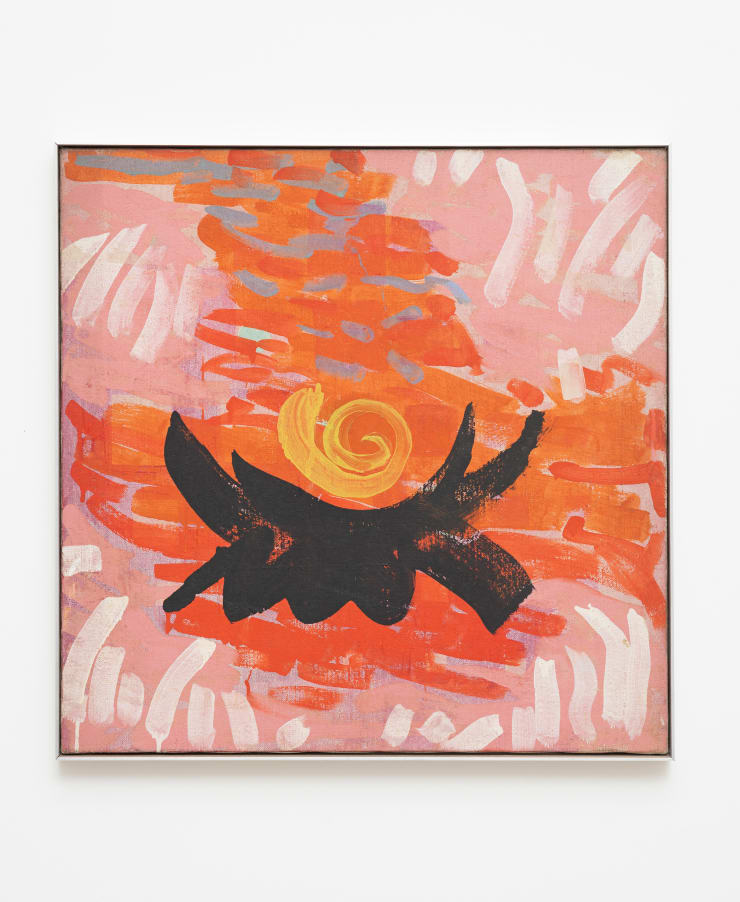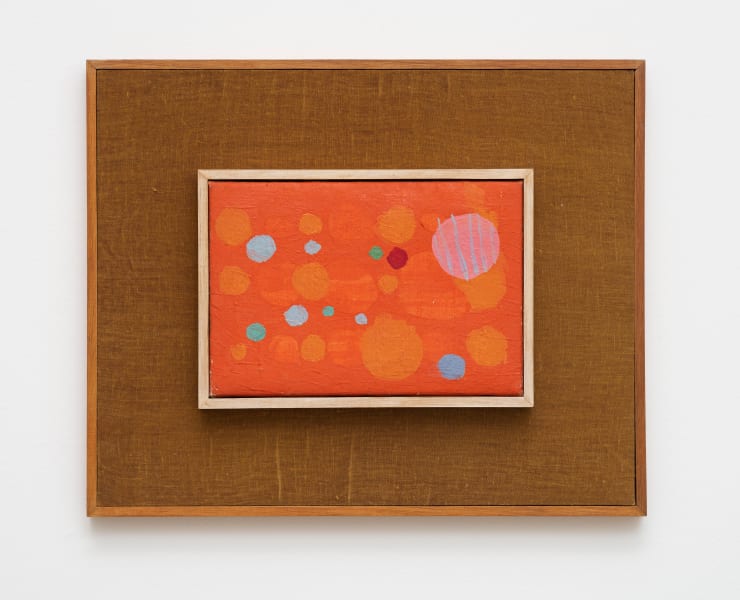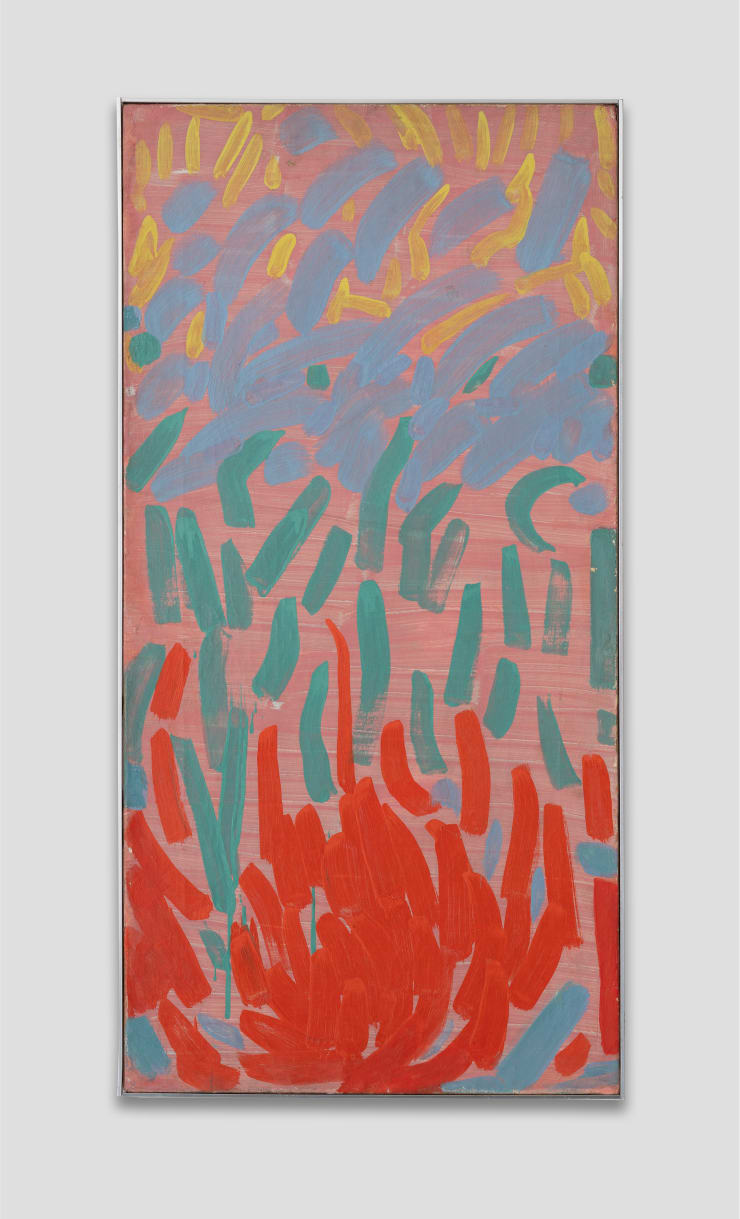-
Waldemar Cordeiro: Geometria Intuitiva
-
“A precisão da arte não é uma precisão artesanal, mas de significados, pode-se construir com rigor sem contornos rigorosos. Forma não é contorno nem invólucro, mas relação.”
Waldemar Cordeiro, 1960
-
Waldemar Cordeiro foi um dos principais agentes da história da arte brasileira, figura chave para a transição da arte moderna para a contemporaneidade, sendo precursor de movimentos artísticos, como o Concretismo e a Computer Art no Brasil e no exterior, além de exímio paisagista. Com ideias e conceitos atemporais, toda a sua produção artística, interdisciplinar, seguiu uma evolução coerente, passando por fases de investigação que atualmente representam marcos dentro das artes visuais no Brasil, como a figurativa, Arte Concreta, Popcreto e Arte de Computador. Tão importante quanto, uma destas fases é muito pouco estudada e praticamente desconhecida do público: “Geometria Intuitiva”.
Situada cronologicamente entre as fases da Arte Concreta e Popcreto, entre 1960 e 1963, a fase Geometria Intuitiva ganha, pela primeira vez na história, o reconhecimento de sua importância com a exposição “Waldemar Cordeiro: Geometria Intuitiva”, na Luciana Brito Galeria. Enquanto a fase Concretista (déc. de 1950), que partia da renovação dos valores das artes visuais e do processo criativo, seguindo um apelo estético Construtivista, trabalhava com as cores primárias (amarelo, vermelho e azul) e linhas geométricas precisas, a Geometria Intuitiva de Waldemar Cordeiro também manteve a mesma organização espacial da tela, mas deixou de lado a régua e o compasso para aderir ao desenho e às cores livres, ou seja, as cores primárias combinadas para atingir outras tonalidades, como as acrescidas de branco ou preto, ou misturadas entre si. Ambas as pesquisas, a Concreta e a Geometria Intuitiva, combinavam as cores em composições espacialmente organizadas para atingir diretamente a percepção inata do espectador.
-
De acordo com os princípios da Gestalt, o todo é mais importante do que as partes, sendo o conjunto completo da composição o que irá envolver os sentidos de quem a observa, que entende a informação por meio de níveis de interpretação, desde a visualidade primeira até nossas emoções e repertórios próprios. A estes conceitos, que já vinham sendo estudados pelo Concretismo, a “Geometria Intuitiva” de Waldemar Cordeiro associou na abstração, numa ousadia inédita, o cromatismo tipicamente brasileiro. As variantes tonais que refletem o clima e a luminosidade próprios da tropicalidade, como os rosas, verdes, laranjas, roxos, amarelos, etc, foram combinadas nas telas de pinturas a óleo, por meio de traços que muitas vezes foram inspirados da morfologia das plantas brasileiras, outro interesse de Waldemar Cordeiro, que a essa altura, já estudava as plantas nativas da Serra do Mar. Totalizando mais de 30 trabalhos, além das pinturas da série “Geometria Intuitiva”, a mostra reúne um conjunto de desenhos raros realizados por Waldemar Cordeiro para ilustrar sua investigação botânica, estabelecendo um diálogo direto com a própria cena paisagística criada por Burle Marx, presente no espaço modernista da galeria.
Waldemar Cordeiro dedicou sua vida por uma arte acessível a todos, buscando um senso coletivo que alinhava a tecnologia, design e o paisagismo, sempre associada a uma preocupação social e política. Seu legado quebrou paradigmas e transformou a forma como ver e fazer arte no Brasil, incorporando a ela conteúdo e objetividade. O que poucos consideram, no entanto, é a importância da fase da “Geometria Intuitiva” em trazer conceitos pertinentes à uma visualidade tipicamente brasileira na abstração, fato que o posiciona como o grande pivô na transição para a arte contemporânea no Brasil.
-
Sobre Waldemar Cordeiro
1925, Roma, Itália – 1973, São Paulo, BrasilWaldemar Cordeiro foi uma das figuras mais importantes para a instauração da arte concreta, movimento de vanguarda fundamental para a transição da arte moderna para a contemporaneidade, o que viria a definir a arte brasileira do século XX. Além de ser pioneiro na arte de computador ainda no final da década de 1960, Waldemar Cordeiro desenvolveu e implementou projetos paisagísticos importantes no Brasil. Em sua pesquisa interdisciplinar, defendia a pintura em sua essência, com linhas e cores básicas que se sustentavam por si só, sem o respaldo da representação figurativa. Primava por uma arte objetiva e racional, muito associada aos seus estudos teóricos, além da investigação de materiais e elementos industriais. Cordeiro trabalhava por uma arte acessível a todos, buscando um senso coletivo que se alinhava também à tecnologia, ao design e ao paisagismo. Sua pesquisa na arte sempre esteve associada a uma preocupação social e política.
Waldemar Cordeiro estudou na Academia de Belas Artes de Roma (1938) e no Liceu Tasso de Roma (1945). Em 1949, estabeleceu-se no Brasil. Participou da mostra inaugural do Museu de Arte Moderna de São Paulo, Do figurativismo ao abstracionismo (1949), e da I Bienal de São Paulo (1951). Também foi um dos organizadores da mostra Ruptura, também no MAM-SP (1952), e Arteônica, na Fundação Armando Alvares Penteado, FAAP-SP (1971). Entre as principais exposições individuais, estão as do MAM-RJ/SP, CCSP, Buffalo University (EUA), MAC-SP, Itaú Cultural, São Paulo, e Paço Imperial, Rio de Janeiro. Entre as mostras coletivas, destacam-se as ocorridas no The Walk Art Center (EUA), Pinacoteca de São Paulo, The Museum of Fine Arts Houston (EUA), Museum of Modern Art, MoMA, NY (EUA), CCBB-SP/RJ, Goethe-Institut, Nova York (EUA), Museo Nacional Centro de Arte Reina Sofía, Madri (Espanha), Instituto Tomie Ohtake, São Paulo, Bienal de São Paulo (2012, 1975, 1973, 1969, 1967, 1965, 1963, 1961, 1959, 1957, 1955, 1953 e 1951), Bienal de Nuremberg (Alemanha), entre outros. As obras de Waldemar Cordeiro integram coleções como a da Fundação de Arte Cisneros Fontanals (EUA), Museu de Arte Contemporânea da Universidade de São Paulo, Coleção Patricia Phelps de Cisneros (EUA), Pinacoteca de São Paulo, Museum of Modern Art, MoMA, Nova York (EUA), The Museum of Fine Arts, Houston (EUA), ZKM Museum (Alemanha), entre outras.
-
Fotografias: Edouard Fraipont
Texto: Tatiana Gonçales
-
Waldemar Cordeiro: Geometria Intuitiva
English -
“The precision of art is not a precision of craftsmanship, but of meanings; one can construct rigorously without rigorous outlines. Form is neither an outline nor a wrapper, but a relationship.”
Waldemar Cordeiro, 1960
-
Waldemar Cordeiro was one of the main agents in the history of Brazilian art, a key figure for the transition of modern to contemporaneity art, being a forerunner of artistic movements such as Concretism and Computer Art in Brazil and worldwide, as well as an eminent landscape architect. With atemporal concepts and ideas, his entire interdisciplinary artistic production followed a coherent development, passing through phases of investigation that currently stand as milestones in the history of the visual arts in Brazil: figurativism, Concrete Art, Popcreto, and Computer Art. One of his phases which is just as important as the others but has nevertheless been little studied and still remains practically unknown to the public, is his “Intuitive Geometry” phase.
Situated chronologically between his Concrete Art and Popcreto phases, between 1960 and 1963, his Intuitive Geometry phase is now having its importance duly recognized, for the first time in history, at the exhibition Waldemar Cordeiro: Geometria Intuitiva [Waldemar Cordeiro: Intuitive Geometry], at Luciana Brito Galeria. This phase followed his Concrete Art phase (1950s), which for its part involved a renewal of the values of the visual arts and of the creative process following an appeal to constructivist esthetics and working with the primary colors (yellow, red and blue) and precise geometric lines. From his investigations of Concrete art, Cordeiro then advanced into his Intuitive Geometry phase, in which he maintained the same spatial organization of the canvas but abandoned the use of a ruler and compass in order to obtain freer lines and colors, combining primary colors and adding white or black, to achieve other hues. In both these investigations – Concrete Art and Intuitive Geometry – colors were combined in compositions that were organized spatially to directly reach the viewer’s innate perception.
-
According to the principles of Gestalt, the whole is more important than the parts, as the overall set of the composition is what evokes the feelings of the observer, who understands the information through levels of interpretation, beginning at the primary stage of vision and leading up through one’s individual emotions and repertoires. With highly unique boldness, in his Intuitive Geometry phase Cordeiro took these concepts – which he had previously studied through Concretism – and coupled them with a typically Brazilian coloration and an abstractionist bent. The different hues that reflect the climate and lighting proper to tropicality, such as the pinks, greens, oranges, purples, yellows, etc., were combined in his oil-on-canvas works with lines often inspired in the morphology of Brazilian plants – another of Cordeiro’s interests, as around this time he was studying plants native to Brazil’s Serra do Mar [coastal rain forest] biome. Totaling more than 30 works, as well as paintings from his Intuitive Geometry series, the show features a set of rare drawings made by Cordeiro to illustrate his botanical investigation, establishing a direct dialogue with the landscape architecture designed by Burle Marx all around the gallery’s modernist space.
Cordeiro dedicated his life to creating an art accessible to everyone, seeking a collective sense that aligned technology, design and landscape architecture, always linked with a social and political concern. His legacy broke paradigms and transformed the way of seeing and making art in Brazil, imparting content and objectivity to it. An aspect so far seldom considered, however, is the importance of his Intuitive Geometry phase, insofar as it dealt with concepts pertaining to a typically Brazilian visuality in abstraction, making it a pivotal milestone in the transition to contemporary art in Brazil.
-
About Waldemar Cordeiro
1925, Rome, Italy – 1973, São PauloWaldemar Cordeiro was a key figure in the development of concrete art, a vanguard movement essential for the transition of modern art to contemporary art, which came to define 20th-century Brazilian art. Besides being a pioneer in computer art as early as the 1960s, Waldemar Cordeiro developed and implemented important landscaping designs in Brazil. In his interdisciplinary research he defended painting in its essence, with self-supporting basic colors and lines, without the backing of figurative representation. He was notable for his objective and rational art, very much associated to his theoretical studies, as well as for his investigation of industrial materials and elements. Cordeiro worked for an art accessible to all, seeking a collective sense that was also aligned with technology, to design and to landscaping. His research in art was always coupled with a social and political concern.
Waldemar Cordeiro studied at the Academy of Fine Arts of Rome (1938) and at the Tasso Lyceum of Rome (1945). In 1949, he took up residence in Brazil. He participated in the inaugural show of the Museu de Arte Moderna of São Paulo (MAM-SP), Do figurativismo ao abstracionismo (1949), and in the 1st Bienal de São Paulo (1951). He was also one of the organizers of the show Ruptura, also at MAM-SP (1952), and of Arteônica, at Fundação Armando Alvares Penteado, FAAP-SP (1971). Solo shows of his work have been held at noteworthy venues, including MAM-RJ/SP, CCSP, Buffalo University (USA), MAC-SP, Itaú Cultural, São Paulo, and the Paço Imperial, Rio de Janeiro. Group shows featuring his work have been held at important venues which include the Walker Art Center (USA), the Pinacoteca de São Paulo, the Museum of Fine Arts Houston (USA), the Museum of Modern Art (MoMA), New York (USA), CCBB-SP/RJ, Goethe-Institut, New York (USA), the Museo Nacional Centro de Arte Reina Sofía, Madrid (Spain), Instituto Tomie Ohtake, São Paulo, the Bienal de São Paulo (2012, 1975, 1973, 1969, 1967, 1965, 1963, 1961, 1959, 1957, 1955, 1953 and 1951), and the Biennial of Nuremberg (Germany). Waldemar Cordeiro’s works figure in many prominent collections, including those of the Cisneros Fontanals Art Foundation (USA), the Museu de Arte Contemporânea of the University of São Paulo, the Patricia Phelps de Cisneros Collection (USA), the Pinacoteca de São Paulo, the Museum of Modern Art (MoMA) of New York (USA), the Museum of Fine Arts, Houston (USA), and ZKM Museum (Germany).
-
Photography: Edouard Fraipont
Text: Tatiana Gonçales














